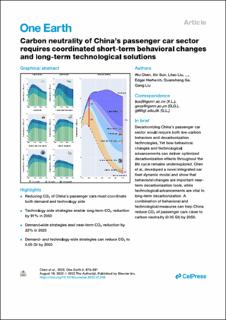| dc.contributor.author | Chen, Wu | |
| dc.contributor.author | Sun, Xin | |
| dc.contributor.author | Liu, Litao | |
| dc.contributor.author | Liu, Xiaojie | |
| dc.contributor.author | Zhang, Rui | |
| dc.contributor.author | Zhang, Shaohui | |
| dc.contributor.author | Xue, Jinjun | |
| dc.contributor.author | Sun, Qian | |
| dc.contributor.author | Wang, Minxi | |
| dc.contributor.author | Li, Xin | |
| dc.contributor.author | Yang, Jianxin | |
| dc.contributor.author | Hertwich, Edgar G. | |
| dc.contributor.author | Ge, Quansheng | |
| dc.contributor.author | Liu, Gang | |
| dc.date.accessioned | 2023-02-21T11:54:53Z | |
| dc.date.available | 2023-02-21T11:54:53Z | |
| dc.date.created | 2022-11-08T14:36:52Z | |
| dc.date.issued | 2022 | |
| dc.identifier.citation | One Earth. 2022, 5 (8), 875-891. | en_US |
| dc.identifier.issn | 2590-3330 | |
| dc.identifier.uri | https://hdl.handle.net/11250/3052720 | |
| dc.description.abstract | The passenger car sector accounts for nearly half of all transport-related emissions. Rapid decarbonization is therefore important but challenging, particularly in China, where, despite recent emission peak (by 2030) and carbon-neutrality (by 2060) pledges, car ownership and associated emissions are increasing. Successful emissions reduction will require a rapid transition of both technology (e.g., toward electrification) and demand (e.g., driving less). However, how to successfully deploy these twin strategies for optimal outcomes remains unclear. Here, we develop an integrated fleet dynamics model that considers emissions associated with car manufacturing, operation, end-of-life recycling, and energy supply alongside socioeconomic changes. Our analyses reveal that optimal short-term results will be achieved through demand-oriented strategies, which can reduce emissions by 22% and achieve 2030 emissions peak targets. Technology-oriented strategies are more optimal when deployed in the longer term and can result in emission reductions of 91%. A successfully coordinated strategy could reduce China’s passenger cars CO2 emissions to 0.05 Gt by 2050. | en_US |
| dc.language.iso | eng | en_US |
| dc.publisher | Elsevier | en_US |
| dc.relation.uri | https://doi.org/10.1016/j.oneear.2022.07.005 | |
| dc.rights | Navngivelse-Ikkekommersiell 4.0 Internasjonal | * |
| dc.rights.uri | http://creativecommons.org/licenses/by-nc/4.0/deed.no | * |
| dc.title | Carbon neutrality of China's passenger car sector requires coordinated short-term behavioral changes and long-term technological solutions | en_US |
| dc.title.alternative | Carbon neutrality of China's passenger car sector requires coordinated short-term behavioral changes and long-term technological solutions | en_US |
| dc.type | Peer reviewed | en_US |
| dc.type | Journal article | en_US |
| dc.description.version | acceptedVersion | en_US |
| dc.description.version | publishedVersion | en_US |
| dc.source.pagenumber | 875-891 | en_US |
| dc.source.volume | 5 | en_US |
| dc.source.journal | One Earth | en_US |
| dc.source.issue | 8 | en_US |
| dc.identifier.doi | 10.1016/j.oneear.2022.07.005 | |
| dc.identifier.cristin | 2070680 | |
| cristin.ispublished | true | |
| cristin.fulltext | postprint | |
| cristin.fulltext | original | |
| cristin.qualitycode | 1 | |

